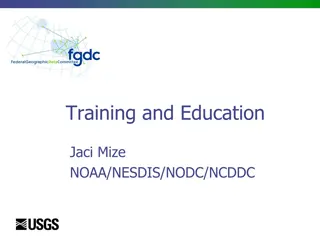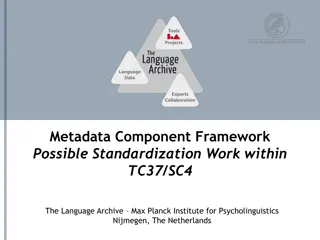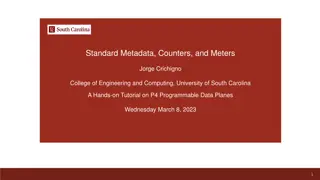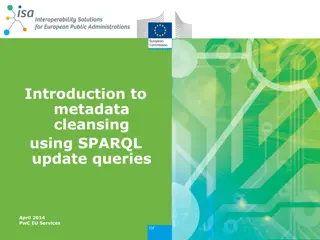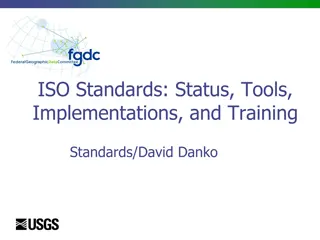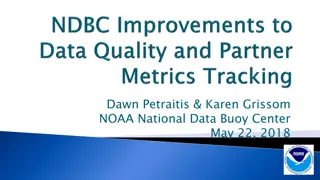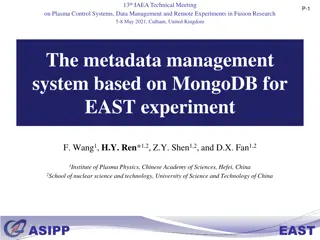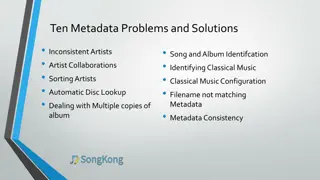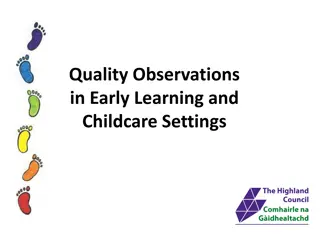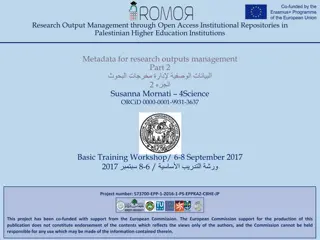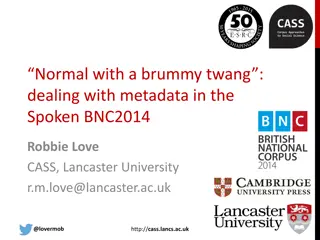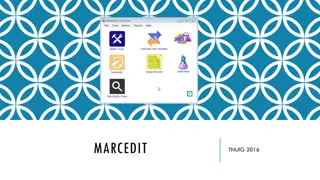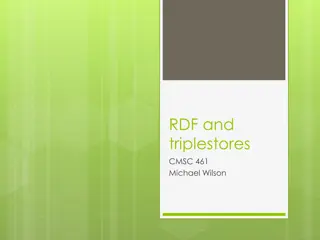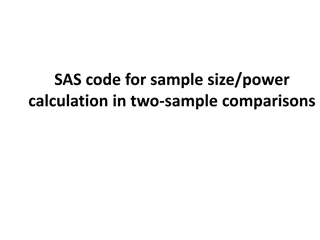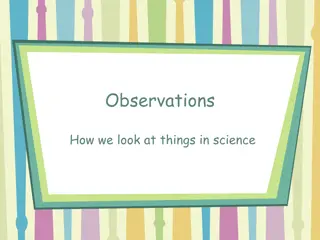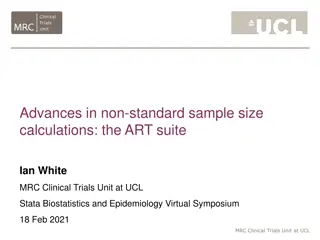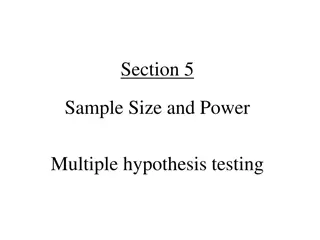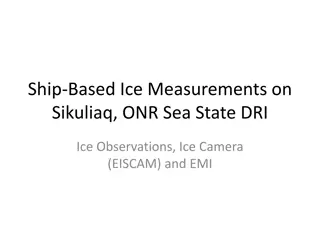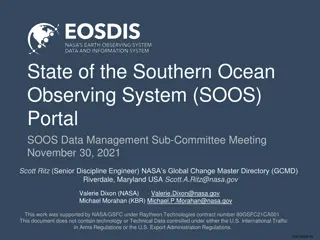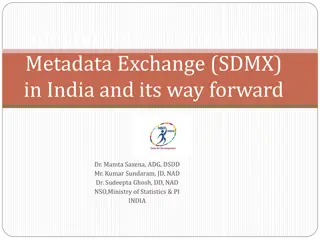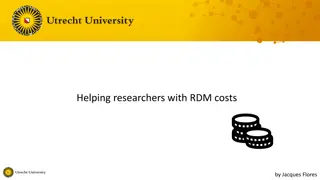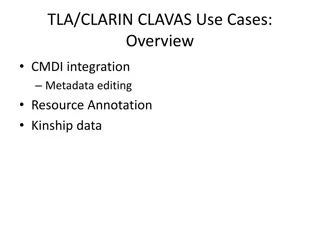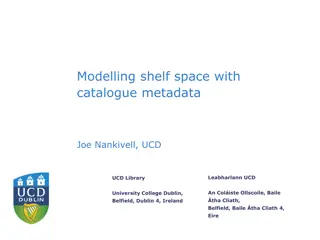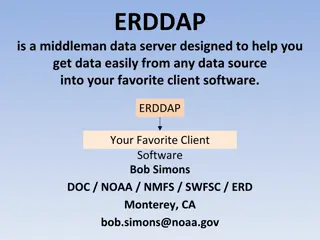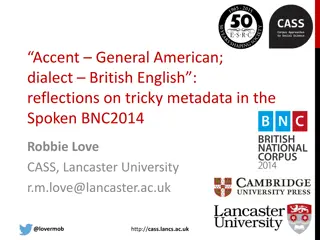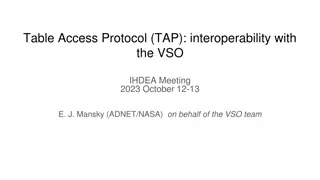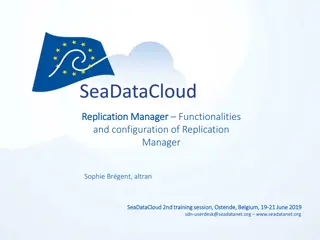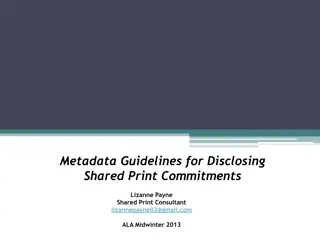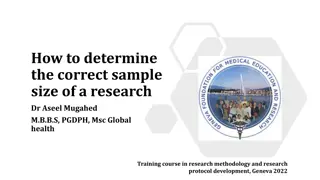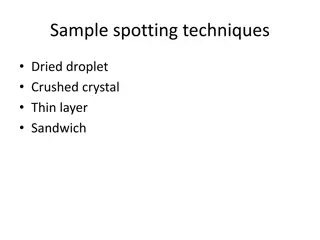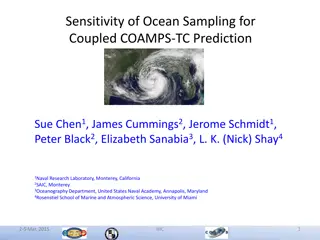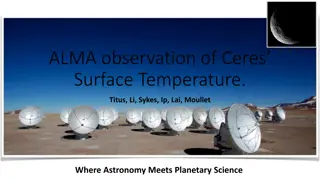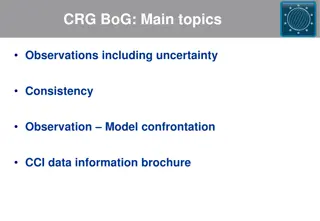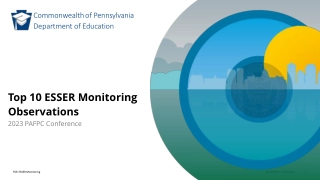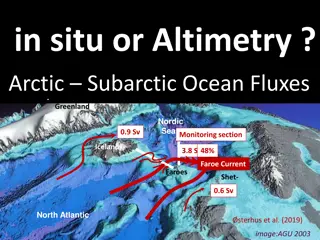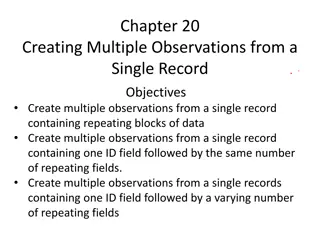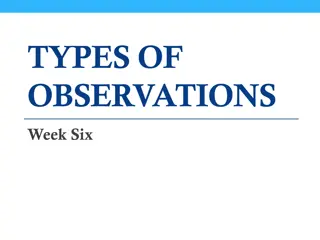Metadata Standards for Sample-Based Observations
"Exploring the importance of metadata standards for sample-based observations, this comprehensive guide covers various aspects such as soil sampling, legacy repositories, policies, and best practices. Learn about the role of metadata in discovering, accessing, and preserving samples for long-term sharing and interoperability across disciplines and globally."
Download Presentation

Please find below an Image/Link to download the presentation.
The content on the website is provided AS IS for your information and personal use only. It may not be sold, licensed, or shared on other websites without obtaining consent from the author. Download presentation by click this link. If you encounter any issues during the download, it is possible that the publisher has removed the file from their server.
E N D
Presentation Transcript
Metadata Standards for Sample- Based Observations Kerstin Lehnert EGU General Assembly 2011
Samples: Part of Earth Observations Soil sampling at the Shale Hill Critical Zone Observatory, Pennsylvania Remotely Operated Platform for Ocean Science (ROPOS) collecting sediment push-core 3
Sampling Legacy US Polar Rock Repository (Ohio State University) Bremen Core Repository (MARUM) 4
Why Metadata Standards? Policies & Best Practices for sample documentation (sample repositories, data systems, publications) Discovery & access of samples Context for observations made on samples Long-term preservation Sharing of samples across disciplines and globally Interoperability between sample-based observation data systems between sample-based and sensor-based observation data systems 5
Observations Feature of Interest Observation Result Observation (OGC O&M 2.0.0 / ISO19156; editor: Simon Cox) 6
Observations Sampling Feature Feature of Interest Observation Result Sampling Observation e.g. Station, Transect, Section Observations commonly involve sampling of an ultimate feature of interest. This International Standard defines a common set of sampling feature types classified primarily by topological dimension, as well as samples for ex-situ observations. (OGC O&M 2.0.0 / ISO19156; editor: Simon Cox) 7
Sample-Based Observations Feature of Interest Specimen Sampling Observation Observation A Specimen is a physical sample, obtained for observation(s) carried out ex situ, sometimes in a laboratory. The class SF_Specimen is a specialized SF_SamplingFeature. (OGC O&M 2.0.0 / ISO19156; editor: Simon Cox) 8
The Data Cube for Observations Tarboton et al. 2007 CUAHSI Community Observations Data Model (ODM) , Version 1.0 9
Sample-Based Observations Observation 1: V1 at T1 & L1 Observation 2: V2 at T2 & L2 Observation 3: V3 at T3 & L3 Time, T Sample Space, L 10
Sample Attributes For example: + degree of alteration + cruise name + depth in core Application or sample specific attributes Basic attributes <<Feature Type>> Location SF_Specimen + materialClass: GenericName + samplingTime: TM_Object + samplingLocation: GM_Object [0..1] + samplingMethod: SF_Process [0..1] + currentLocation: Location [0..1] + specimenType: GenericName [0..1] + size: Measure [0..1] OGC 2.0.0 12
Requirements for Sample Metadata Discovery Metadata Where was the sample collected? What type of sample is it? Where is it now? Sample specific Metadata Rock texture Age Spatial relation to parent sample ( depth in core ) Unique Identification Unambiguously link data and sample Integrate disparate data Metadata that allow to track relations to sub-samples and observations made on them 13
Sample-Based Data Systems Example: Geochemical Observations 14
Integrating Sample-Based Data in ODM2.0 Development by J. Horsburgh D. Tarboton K. Lehnert A. Aufdenkampe C. Chan M. Williams I. Zaslasvsky 16
Sample Identification Name D3-1 D3-1 D3-1 D3-1 3-1 Location SEIR North Fiji Basin EISSEN 1994 Shimada Smt Gorda Ridge Lamont Smts Publication ANDERSON, 1980 VM3301 (Vema) Cruise Starmer 1 (Nadir) S1-79 (Sea Sounder) KK2-83NP (Kana Keoki) RISE III (New Horizon) GRAHAM 1988 CLAGUE 1984 BATIZA 1982 Examples from the PetDB Database Sample names are duplicated. Dredge sample 3, Amphitrite Cruise 1963/4 D3 D-3 PD3 PD-3 PV D-3 AMPH3D AMPH-D3 AMPH D-3 AMPH 3-PD-3 S-10 Engel 1964 Scheidegger 1981, Schilling 1971 Tatsumoto 1965, 1966 Hedge 1970, Muehlenbach 1972 Engel 1965 Pineau 1976 MacDougall 1986 Sun 1980, Schilling 1975 Hart 1971 Subbarao 1972 Sample names are modified or changed.
International GeoSample Number A Global Unique Identifier for Earth Samples IGSN:ODP010FMZ Name space Current syntax: 9 digits, alphanumeric First three characters: name space = unique user code (registered with SESAR) Last 6 characters: random alphanumeric string Allows 2,176,782,336 sample identifiers per registrant Does not replace personal or institutional names. Applied to samples & sub-samples system tracks relations www.geosamples.org 18
Linking Samples & Data with the IGSN IGSN:KAL07H9Y8 IGSN:KAL07H9Y8 Sample Repository IGSN:KAL07H9Y8 IGSN:KAL07H9Y8 Publication Sub-sample (child) IGSN:KAL99JK49 IGSN:KAL07H9Y8 Data System IGSN:KAL99JK49 Publication sub-sample 19
IGSN Metadata Profiles Identification metadata Sample name(s), registrant Descriptive metadata Material, classification, age, size, comments Geospatial metadata Geographical names, coordinates Collection metadata Expedition/cruise, platform, date, collector, technique Archival metadata Physical location of sample (repository), contact
IGSN Workshop Agencies USGS (S. Bristol, B. Buczkowski) NOAA (T. Habermann, A. Milan) AASG (S. Richards) Geoscience Australia (L. Wyborn) Standards OGC (S. Cox, I. Zaslavsky) ISO (S. Cox, T. Habermann, A. Milan) GeoSciML (S. Richards) WaterML (D. Valentine) INSPIRE (S. Cox) DataCite (J. Klump) Organizations, Programs & Projects ICDP/IODP (J. Klump, R. Conze) US Ext. Cont. Shelf Program (B. Buczkowski) CZO (T. Whitenack, I. Zaslasvky) CUAHSI (D. Valentine, I. Zaslavsky) NGDC (T. Habermann) ANDS/AuScope (L. Wyborn) National Digital Catalog (S. Bristol) R2R (R. Arko, S. Miller) IEDA (MGDS, SESAR, EarthChem) San Diego Supercomputing Center Feb 22-24, 2011 Advancing the International Geo Sample Number IGSN as an International Standard for Sample Identification 21
IGSN Workshop Results: Participants agreed on the value of an internationally unified approach for registration and discovery of physical specimens in the Geoscience community. Designed new modular and scalable IGSN architecture. 22
Management Layers in the IGSN System Define IGSN scope Register top-level registrars Define IGSN syntax Maintain IGSN handle system Validate identifier registration IGSN eGeosamples Implementation Board Register name spaces, aggregate metadata for namespaces Validate metadata content for specimen registration Maintain clearinghouse portal for accessing specimen metadata in their registered name spaces Near Space Observatory (invented example) ExoPlanet (invented example) SESAR Registrar Establish detailed specimen description schema Geoscience Australia Registration Agent IEDA USGS CZO Validate metadata content for specimens Handle interaction with specimen collectors and curators to register specimens ICDP Make decisions about what specimens merit registration Maintain physical collections Initiate registration of specimens Registers samples through one of the higher level namespaces Registrant Analytical Lab Repository Investigator
IGSN Workshop Results: Participants agreed on the value of an internationally unified approach for registration and discovery of physical specimens in the Geoscience community. Designed new modular and scalable IGSN architecture. Generated draft of IGSN Registration Metadata and SESAR Discovery Metadata compliant with international standards from ISO and OGC. 24
Metadata IGSN Registration - - - - - IGSN ResourceURI Registrant ID timeStamp status SESAR Discovery - - - - - - - - - - - - IGSN Registrant MetadataTimeStamp Title Description SamplingLocation SamplingTime Distributor Originator SpecimenType MaterialClass SamplingMethod ISO & OGC O&M compliant Agent Catalog - - - - - - - - IGSN SampleEvent SamplePhysicalSize RelatedResource SamplingMethodDetails ProcessingHistory CurationHistory More local detail 25
IGSN Workshop Results: Participants agreed on the value of an internationally unified approach for registration and discovery of physical specimens in the Geoscience community. Designed new modular and scalable IGSN architecture Generated draft of IGSN Registration Metadata and SESAR Discovery Metadata compliant with international standards from ISO and OGC. Committed to establishing a formal governance structure. International IGSN Implementation Board to govern the IGSN, an incorporated not-for-profit organization. A Science Advisory Board to support & guide policies, technology, and procedures of the SESAR Metadata Clearinghouse and the local agents. 26
Challenge: Implementation Consistent vocabularies & classification schemes Metadata capture & reporting Unique identifier (IGSN) In sample acquisition & curation In data management In publications Across disciplines Globally 27
Metadata! Percentage of publications that lists geospatial coordinates for sample locations 60% 50% 54% 40% 30% Example: Journal of Petrology 20% 28% 10% 0% 2005 2009 28 LDEO Data Lunch March 31, 2011


